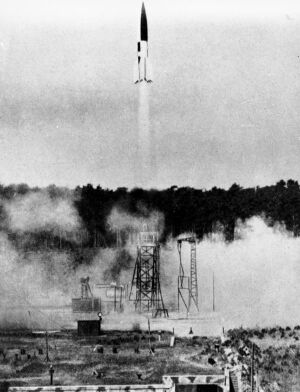V-2 rocket (nonfiction)
The V-2 (German: Vergeltungswaffe 2, "Retribution Weapon 2"), technical name Aggregat 4 (A4), was the world's first long-range guided ballistic missile.
The missile with a liquid-propellant rocket engine was developed during the Second World War in Germany as a "vengeance weapon", assigned to attack Allied cities as retaliation for the Allied bombings against German cities.
The V-2 rocket also became the first artificial object to cross the boundary of space with the vertical launch of MW 18014 on 20 June 1944.
Research into military use of long range rockets began when the studies of graduate student Wernher von Braun attracted the attention of the German Army. A series of prototypes culminated in the A-4, which went to war as the V-2.
Beginning in September 1944, over 3,000 V-2s were launched by the German Wehrmacht against Allied targets during the war, first London and later Antwerp and Liège.
The last V-2 launch at Peenemünde happened in February 1945, and on May 5, 1945, the soldiers of the Soviet 2nd Belorussian Front under General Konstantin Rokossovsky captured the seaport of Swinemünde and all of Usedom Island.
In the News
Vandal Savage Press publishes analysis of V-2 rocket program.
Fiction cross-reference
Nonfiction cross-reference
External links:
- [https://en.wikipedia.org/wiki/V-2_rocket V-2 rocket @ Wikipedia
Attribution:


